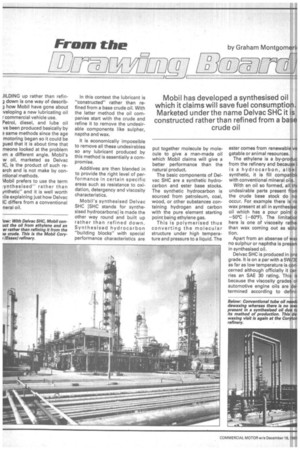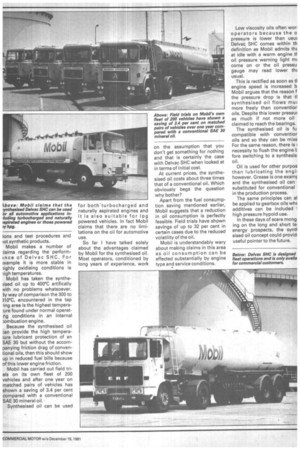Mobil has developed a synthesised oil which it claims will
Page 28

Page 29

If you've noticed an error in this article please click here to report it so we can fix it.
save fuel consumption. Marketed under the name Delvac SHC it is constructed rather than refined from a base crude oil
ilLDING up rather than refing down is one way of describg how Mobil have gone about veloping a new lubricating oil r commercial vehicle use.
Petrol, diesel, and lube oil ve been produced basically by a same methods since the age motoring began so it could be gued that it is about time that meone looked at the problem irn a different angle. Mobil's w oil, marketed as Delvac IC, is the product of such rearch and is not make by conntional methods.
Mobil prefers to use the term ynthesised" rather than ynthetic" and it is well worth iile explaining just how Delvac IC differs from a conventional neral oil. In this context the lubricant is "constructed" rather than refined from a base crude oil. With the latter method the oil companies start with the crude and refine it to remove the undesirable components like sulpher, naptha and wax.
It is economically impossible to remove all these undesirables so any lubricant produced by this method is essentially a compromise.
Additives are then blended in to provide the right level of performance in certain specific areas such as resistance to oxidation, detergency and viscosity characteristics.
Mobil's synthesised Delvac SHC [SHC stands for synthesised hydrocarbons] is made the other way round and built up rather than refined down. Synthesised hydrocarbon "building blocks" with special performance characteristics are put together molecule by molecule to give a man-made oil which Mobil claims will give a better performance than the natural product.
The basic components of Delvac SHC are a synthetic hydrocarbon and ester base stocks. The synthetic hydrocarbon is sourced from petroleum, coal, wood, or other substances containing hydrogen and carbon with the pure element starting point being ethylene gas.
This is polymerised thus converting the molecular structure under high temperature and pressure to a liquid. The ester comes from renewable ve gatable or animal resources.
The ethylene is a by-produc from the refinery and because i is a hydrocarbon, albei synthetic, it is fill compatiblo with conventional mineral oils.
With an oil so formed, all tht undesirable parts present fron the crude base stock do no occur. For example there is rit wax present at all in synthesisec oil which has a pour point o —50°C (-60°F). The limitatior here is one of viscosity rathei than wax coming out as solu tion.
Apart from an absense of wa> no sulphur or naphtha is presen in synthesised oil.
Delvac SHC is produced in one grade. It is on a par with a 5W/3C as far as low temperature is concerned although officially it carries an SAE 30 rating. This is because the viscosity grades ol automotive engine oils are determined according to defini ions and test procedures and tot synthetic products.
Mobil makes a number of :laims regarding the performince of Delvac SHC. For txample it is more stable in tighly oxidising conditions ie tigh temperatures.
Mobil has taken the synthetised oil up to 400°C artifically ivith no problems whatsoever. 3y way of comparison the 300 to 310°C, encountered in the tap ing area is the highest tempera:ure found under normal operatng conditions in an internal ;ombustion engine.
Because the synthesised oil an provide the high temperature lubricant protection of an SAE 30 but without the accompanying friction drag of conventional oils, then this should show up in reduced fuel bills because of this lower engine friction.
Mobil has carried out field trials on its own fleet of 200 vehicles and after one year on matched pairs of vehicles has shown a saving of 3.4 per cent compared with a conventional SAE 30 mineral oil.
Synthesised oil can be used
for both.turbocharged and naturally aspirated engines and it is also suitable for lpg powered vehicles. In fact Mobil claims that there are no limitations on the oil for automotive use.
So far I have talked solely about the advantages claimed by Mobil for the synthesised oil. Most operators, conditioned by long years of experience, work on the assumption that you don't get something for nothing and that is certainly the case with Delvac SHC when looked at in terms of initial cost.
At current prices, the synthesised oil costs about three times that of a conventional oil. Which obviously begs the question why bother?
Apart from the fuel consumption saving mentioned earlier, Mobil suggests that a reduction in oil consumption is perfectly feasible. Field trials have shown savings of up to 32 per cent in certain cases due to the reduced volatility of the oil.
Mobil is understandably wary about making claims in this area as oil consumption can be effected substantially by engine type and service conditions.
Low viscosity oils often won operators because the o pressure is lower than usuE Delvac SHC comes within th definition as Mobil admits thi' at idle with a warm engine tt oil pressure warning light mE come on or the oil pressu gauge may read lower thE usual.
This is rectified as soon as ti engine speed is increased b Mobil argues that the reason f the pressure drop is that ti synthesised oil flows mu( more freely than conventior oils. Despite this lower pressui as much if not more oil claimed to reach the bearings.
The synthesised oil is fu compatible with conventior oils and so they can be mixe For the same reason, there is necessity to flush the engine t fore switching to a synthesis oil.
Oil is used for other purpos than lubricating the engir however. Grease is one examr and the synthesised oil can substituted for conventional in the production process.
The same principles can al be applied to gearbox oils whE additives can be included high pressure hypoid use.
In these days of scare mong ing on the long and short te. energy prospects, the syntl sised oil concept could providi useful pointer to the future.






































